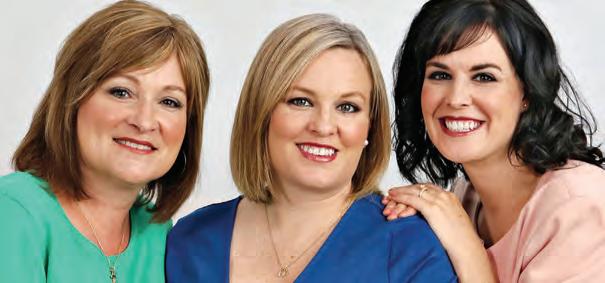
12 minute read
PUBLIC HEALTH Education as health
Education as health A partnership that is changing lives
BY BRUCE CANTOR, MD, MS
Advertisement
Ahigh school diploma or GED (General Educational Development) certificate is required for many jobs, and can boost future earning potential—with incomes rising even higher for those who attend college. Individuals who have completed their education also experience lower rates of preventable conditions and better overall health. One Minnesota health plan is partnering with a national organization to pave the way on all of these fronts for its Medicaid and MinnesotaCare patients.
Covering education as a health benefit
UCare, a nonprofit, community-based health plan serving nearly 300,000 Medicaid and MinnesotaCare members, now works with GEDWorks—the official turnkey education benefit program from the creators of the GED— under a pilot project to serve its members in 18 counties.
The program helps members in select counties improve their employment prospects by paying for their GED-related training, support, and exams. It was an untested concept at the time of development, but the program has already helped participants jumpstart their careers, life aspirations, and
OB & GYN CARE
FOR ALL STAGES OF LIFE
Low- and high-risk obstetrics, including advanced maternal age. Certified nurse midwifery. Gynecologic care, including well-woman screenings and in-office procedures Gynecologic surgeries, including minimally invasive surgeries and robotics for conditions such as endometriosis and pelvic organ prolapse Menopause Clinic, including management of peri-menopause Center for Urinary and Pelvic Health, including urodynamics. Nutrition and wellness consultations. Infertility evaluation and treatment.
Early, late, and Saturday appointments 763-587-7000 OakdaleOBGYN.com MAPLE GROVE BLAINE PLYMOUTH CRYSTAL financial security—and may result in better health outcomes for them and their families.
Local disparities
While Minnesota often ranks high in quality-of-life measures, it has some of the worst disparities in the nation when it comes to education and health. Only 82% of Minnesota students earn a high school diploma within four years; this number is significantly lower for students of color and for immigrant populations. Eighty-seven percent of the state’s White (non-Hispanic) students finish high school on time, followed by Asian students (84%), Hispanic students (65%), Black students (65%), and American Indian students (53%).
When compared with other states, Minnesota ranks 34th out of 50 for overall high school graduation rates, according to data from the U.S. Department of Education. The rankings differ by demographics: the state ranks 32nd for White students, 45th for Native Americans, 46th for Asian Americans, 48th for Black students, and 50th for Hispanic students.
High school incompletion perpetuates the cycle of poverty for these students. According to state data, having a high school diploma or GED increases earning power by 37.5%—a nearly $10,000 per year median wage increase. Education clearly has the power to help lift people out of poverty.
Education and health
How does poor education affect health? According to the American Public Health Association, adults who do not complete high school have poorer health and are more likely to die prematurely from preventable conditions such as cardiovascular disease, diabetes, and lung disease.
Other outcomes for those with different educational histories:
Employment. Among Minnesotans 16 years and older, those with less than a high school diploma have unemployment rates of 13.1%. That rate is 3.1% for those with a bachelor’s degree. (Note: these figures predate the COVID-19 pandemic).
Diabetes. Adults 18 years and older without high school diplomas or GEDs have diabetes rates of 11.1%, compared to 5.4% for those with college degrees.
Prenatal care. Births without first-trimester prenatal care numbered 29% among mothers with a high school diploma or less. For those with more than 12 years of education, the rate was 13.6%.
Smoking. Among those without a high school diploma or GED, smoking rates were 34.6%. Just 7.1% of college graduates smoke.
The 2017 Minnesota Statewide Health Assessment stated: “Education is one of the clearest and strongest predictors of lifelong health. When we have more education, we are more likely to live longer, healthier lives. Success in school leads to higher earnings, and this improves our living conditions. Education allows us to find better-paying jobs, with healthier working conditions and benefits including health insurance and paid leave.”
Children of educated parents are more likely to be healthy, too. Parents who are educated on the value of prevention are more likely to protect their
health and that of their children by scheduling recommended checkups, The pilot program is capped at 200 members. Member impact will be screenings, and immunizations. evaluated for continuation or further expansion. UCare plans to expand the
Mental health can also benefit from education. In a recent blog post, program to Minnesota communities where assessments show the greatest Vicki Greene, president of the GED Testing Service, refers to a study that need and benefit to our members. We also will continue to expand member found young people who drop out of high school engagement in the 18 counties where the program are more likely to be depressed than high school is currently available. graduates in their early adult years. “Adults with Success stories higher levels of education often have better people UCare’s first member graduate, Lydia from Blue skills, are afforded more advantages, and tend to have better coping mechanisms—all of which lead Minnesota ranks 34th out of 50 for overall high Earth County, earned her credential in 2019 after years of wanting to do so but lacking the finances to better mental health,” she wrote. school graduation rates. to pay for it. Lydia’s mental health issues in high Health literacy school caused her to leave before graduation. The U.S. Department of Health and Human Through GEDWorks, she was able to take practice Services (HHS) defines health literacy as “the tests and work closely with a personal advisor. degree to which individuals have the capacity Within a month, she took the four GED tests and to obtain, process, and understand basic health passed. Upon earning her GED, she applied and information needed to make appropriate health decisions.” It comes as no was accepted to a local university, where she’ll start this fall. surprise that people with lower education levels struggle more to understand Irene from Montgomery, Minnesota, dropped out of school after health terms, prescription instructions, and treatment plans. In more than eighth grade to work. She had immigrated to Texas from Mexico at age 12, one national study, low health literacy was directly related to poorer health and later moved to Minnesota to join relatives and take a job with Seneca and lower educational status. Foods. For years the 45-year-old mother of four would attempt to study
Individuals with higher educational attainment also tend to use health care for her GED, but found it too hard to stick with it. When she received the resources more appropriately and efficiently—knowing when to see a primary email from UCare inviting her to try the free program, she jumped at the care doctor, use telehealth, visit urgent care, or go to the emergency room. Finally, Education as health to page 224 improved health literacy may empower people to be more proactive about their health and that of their families … and to embrace healthier lifestyles.
GEDWorks: advocacy and support
A high school degree or GED is required for most jobs. Many of us take this level of education for granted, but, as discussed previously, the number of Minnesotans dropping out of high school is surprisingly high. Within UCare’s state public insurance programs, there are members who grew up with the odds stacked against them in impoverished circumstances—where education is difficult to pursue, life is about survival, or families struggle with mental health or substance use disorders.
The UCare–GEDWorks partnership helps these members reverse the course of their lives with an extra level of support, advocacy, and encouragement, and to change the trajectory of their lives through education. The program equips graduates with the skills and knowledge they need to excel both inside and outside the classroom. Many of those who have obtained their GEDs through GEDworks have continued their education, with more than 50% attending college programs. These graduates also go on to pursue successful careers.
Members are matched with a bilingual advisor, online study materials in English and Spanish based on assessment test results, connections to local adult education programs, practice tests, and free GED tests—all paid for by the health plan to provide a second chance at a high school diploma.
Since UCare launched the program in a limited number of Minnesota counties in 2019, there have been nine graduates, with a tenth on track to take the test soon. More than 100 members are enrolled and studying. The program started in four rural counties and has since expanded to 18 counties across the state, including Dakota, Ramsey, and St. Louis counties.
Telephone Equipment Distribution (TED) Program
Do you have patients with trouble using their telephone due to hearing loss, speech or physical disability?
If so…the TED Program provides assistive telephone equipment at NO COST to those who qualify.

Please contact us, or have your patients call directly, for more information.


Duluth • Mankato • Metro Moorhead • St. Cloud
The Telephone Equipment Distribution Program is funded through the Department of Commerce Telecommunications Access Minnesota (TAM) and administered by the Minnesota Department of Human Services
3 Education as health from page 21
chance. Irene aced her practice test and passed her four tests in just two program, which allowed them to pursue a GED without financial barriers, weeks. She appreciated the emotional support from her advisor at every the support of advisors, the resulting career opportunities, and the simplicity step along the way. Irene will be applying for of the program itself. new positions at Seneca Foods for which she now qualifies. The best part—the pride her children Building for success have in her accomplishment. We recommend that primary care doctors For UCare member Christopher, earning his GED was a personal goal. He had wanted to do so for many years, but the cost of preparation Adults who do not complete high school have poorer health. age. Some employers—for example, in the fastfood industry—sponsor free training, support, and tests for their employees. Community and testing were barriers. His previous education education programs often offer affordable GED was inconsistent, after changing schools several workshops and training. Patients who earn their times because of persistent bullying. Christopher GED will not only benefit from higher education successfully completed high school, but his school and career opportunities. They will be empowered lost track of his transcript, so he had no proof of to better understand and take charge of their graduation, which led to missed job opportunities. After studying hard and health and that of their families. completing all four GED tests, Christopher now feels a deep sense of pride and confidence. “It’s a major personal accomplishment which I celebrated Other participants offered similar praise for the health-plan sponsored encourage patients to complete their GED at any with my family,” he said. Bruce Cantor, MD, MS, is a medical director at UCare, a nonprofit,
Our most recent graduate, Vanida, sums up her surprise and community-based Minnesota health plan that offers Medicare, Medicaid, and appreciation for the program. She was aware that some companies offer individual and family coverage. Dr. Cantor earned his MD—and his master’s GED support to their employees but said, “I think that it’s awesome to degree in Health Policy and Administration—from the University of Illinois at know you have some sort of medical assistance, and that they still support Urbana-Champaign. He is board-certified with the American Board of Internal you in getting your GED.” Medicine and the American Board of Pediatrics.


Property Management | New Development Asset Management | Project Management


mspcommercial.com
3 COVID 19 in Greater Minnesota from page 19
For patients seeking testing, CHWs were able to inform our outreach narratives, and realities replaying without end, incessant messages that and educate the community on what to expect, amplifying the impact of continue to devalue Black and Brown humans. our drive-through testing program. For patients We did not build these structural challenges, testing positive for COVID-19, CHWs were vital but we all have the responsibility to change members of an at-home monitoring program. and dismantle them. This may seem daunting, While clinicians kept close tabs on vitals and but everyone can start with themselves. Our symptoms, CHWs were navigating housing or community engagement team facilitates an employment challenges, family communications for hospital transfers, and much more. CHWs Health happens in community. intercultural effectiveness seminar, unpacking individual and institutional biases and assumptions worked in close contact with clinicians to in a cross-cultural lens. After training hundreds of coordinate all aspects of patient care. professionals across health, education, and social It’s everybody’s responsibility service sectors, we continue to see the impact of It seems unimaginable how these tragic times are this work and the institutional change that begins layering on top of each other. Whether emerging with individuals. outbreaks, or symptoms of dynamics in place for centuries, what is certain The time is now to break the cycle. Physicians and health systems share is that they share the same underlying causes: ingrained inequities, persistent in the responsibility to identify new ways of collaboration to solve issues disparities, and institutional racism. These populations in rural Faribault are that cut across our entire society and culture. Ask yourself what you can do poised to grow, with over 30% of the births to non-White families, and the today to change how you practice to dismantle the root causes of racism that school district recently becoming majority non-White. Rural institutions, have produced such disparate outcomes in our patients for too long. including health care, have been slow to adapt to these changing demographics, exacerbating both inequities and the impetus for immediate change.
We see this pain manifest in communities that carry the weight of institutional violence and racism at the hands of law enforcement, both of which have torn families apart. Trauma is caused by the violent images,
Charlie Mandile is the Executive Director at HealthFinders Collaborative, a health care provider with offices in Northfield and Faribault.






